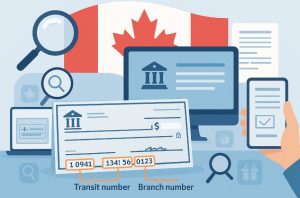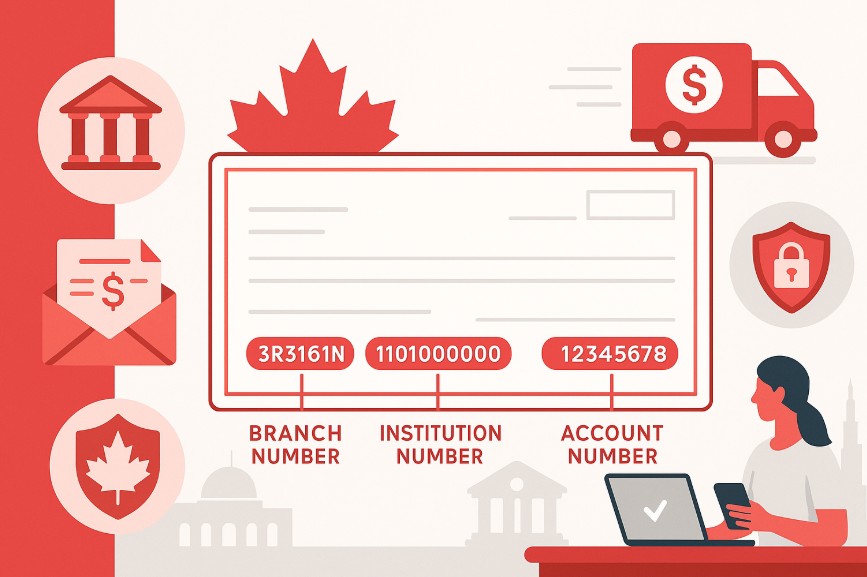Banking in Canada involves a range of numbers that may seem confusing at first glance. If you’ve ever been asked for a branch number or a transit number, you might have wondered if they’re the same or serve different purposes.
When setting up direct deposits, transferring funds, or processing cheques, these codes become essential. Yet, many Canadians remain unclear about what each one means and how they’re used.
Understanding the structure of bank account identification in Canada is critical, especially if you deal with financial paperwork regularly. It can help you avoid delays or errors in transactions.
This blog will guide you through everything you need to know about the branch number vs transit number, clarify their roles, and show you where to find them easily. By the end, you’ll be equipped to handle any banking form with confidence and accuracy, whether it’s personal or business-related.
Why Do Canadian Banks Use Multiple Numbers?

Canada’s banking system relies on specific codes to distinguish accounts, banks, and branches across the country. These identifiers allow for accurate and secure processing of both digital and paper-based transactions. Using multiple numbers helps reduce errors and streamlines the transaction process.
Banks use these codes to manage various tasks:
- Identifying which branch holds the customer’s account
- Verifying the correct financial institution
- Ensuring transactions are routed accurately
- Supporting both domestic and international payments
Each account in Canada is associated with at least three key numbers: the transit number, the institution number, and the account number. Together, they make up a routing number, which is crucial for processing cheques and electronic transfers like direct deposits or bill payments.
The use of separate numbers for institutions and branches increases the precision of financial transactions, especially when millions of accounts exist across thousands of branches.
This layered structure allows each account to be uniquely identified, even within the same bank. Using multiple numbers may seem complex, but it provides clarity and security in every transaction.
What Is a Branch Number in Canada?
In Canadian banking, the branch number is a five-digit code that identifies the specific branch of a financial institution where an account was opened. It’s often used interchangeably with the term transit number, although the broader routing number includes more details.
The branch number is an integral part of the routing system.
It helps banks:
- Trace the origin of the account
- Direct funds to the correct location
- Track payments and transactions more efficiently
You can find the branch number on:
- Cheques (usually the first five digits printed at the bottom)
- Online banking profiles
- Bank statements
Each Canadian bank branch has its own unique number. For example, if you opened an account at a Scotiabank location in Toronto, your branch number would be different from a Scotiabank in Vancouver.
In many cases, the branch number and transit number are considered the same. However, when combined with the institution number, the full routing information becomes complete.
So, while the term branch number refers to the physical location, it’s essential for identifying your exact banking origin within a broader system. The branch number plays a quiet but vital role in Canadian finance.
What Is a Transit Number in Canada?
The transit number in Canada is a five-digit code used to identify the specific bank branch where your account was opened. It is the same as the branch number, though it’s more commonly referred to in the context of routing numbers.
The transit number, when paired with the institution number, forms a routing number, which looks like this:
Transit (5 digits) + Institution (3 digits)
Here’s where you might find your transit number:
- On a personal or business cheque
- Inside your online banking account
- On a bank statement or deposit slip
Key uses of transit numbers include:
- Enabling direct deposit of salaries or pensions
- Supporting electronic transfers such as Interac e-Transfers
- Ensuring accurate routing of cheque-based payments
- Facilitating wire transfers and recurring payments
Every Canadian financial institution uses this standardized format. For example, if your transit number is 10111, and your bank’s institution number is 001, your full routing number would be 10111-001.
Transit numbers ensure the right funds go to the right place. When entering this information online or on paper forms, accuracy is crucial.
How Are Branch Number and Transit Number Different?

You might wonder whether the branch number and transit number are different. The truth is, in Canada, they are essentially the same thing. Both terms refer to the five-digit number identifying the branch where your account is located.
This shared meaning causes confusion, especially for people filling out forms for payroll, direct deposits, or online transfers. But understanding their relationship with other banking codes can make things clearer.
Here’s how they compare:
| Feature | Branch Number | Transit Number |
| Number of digits | 5 | 5 |
| Purpose | Identifies your bank branch | Identifies your bank branch |
| Other Name | Same as transit number | Same as branch number |
| Used In | Routing numbers, cheques | Routing numbers, cheques |
Why the Confusion Exists?
The terms are used interchangeably by banks, but depending on the form or service you’re using, one may be requested over the other. Despite different terminology, both reference the same number.
When to Use Which One?
- Use the term “transit number” for digital banking and routing details
- Use “branch number” when speaking with customer service or reviewing printed documents
As long as the five-digit number is correct, it serves both roles. The distinction is more about context than functionality.
What About Institution Numbers and Routing Numbers?
While the branch and transit numbers identify your specific branch, the institution number identifies your bank as a whole. It is a three-digit code assigned to each financial institution in Canada.
For example:
- RBC: 003
- Scotiabank: 002
- TD Canada Trust: 004
How They Fit Into Canadian Banking Codes?
The routing number combines the transit number (branch) and the institution number.
This eight-digit number is essential for processing:
- Cheque payments
- Electronic Funds Transfers (EFTs)
- Payroll deposits
- Loan repayments
Here’s how routing information is structured:
| Component | Digits | Purpose |
| Transit Number | 5 | Identifies your bank branch |
| Institution Number | 3 | Identifies your financial institution |
| Routing Number | 8 | Complete code for banking systems |
This combination ensures that payments reach not just the right bank, but the exact branch and account. Always double-check this data to avoid transaction errors. Understanding institution and routing numbers helps you manage your finances with confidence.
Where Can You Find Your Branch and Transit Number?

Finding your branch and transit number is simple once you know where to look. Canadian banks provide this information across multiple platforms for easy access.
Here are some common sources:
- Cheques: Look at the bottom line. The first five digits represent the transit or branch number, followed by the three-digit institution number and the account number.
- Online banking: Log into your bank account, and you’ll typically find all banking codes under account details or settings.
- Bank statements: Often include routing information near the top or bottom of the document.
- Deposit slips: Like cheques, these slips usually include routing information.
If your cheque or bank document only shows a four-digit branch or transit number, add a leading zero. For example, 1011 becomes 01011. It’s essential to use accurate information when submitting banking details for automated payments or transfers.
When Do You Need to Use These Numbers?
You’ll need your branch and transit numbers anytime you’re engaging in banking activities that require precise routing of funds.
Some common scenarios include:
- Setting up direct deposit for payroll or government payments
- Making an electronic transfer or Interac e-Transfer
- Authorizing automatic withdrawals for bills or loan payments
- Depositing or issuing a cheque
Whether you’re filling out a form for your employer or registering a new vendor payment, these numbers ensure money lands where it’s supposed to.
If you’re starting a business, these numbers are also necessary to set up vendor payments or receive payments from clients. Using the right codes means fewer delays, no bounced payments, and faster access to your money.
What Happens If You Use the Wrong Code?

Entering the wrong branch or transit number can result in failed transactions or funds being sent to the wrong location. Though banks have systems to catch some errors, mistakes can still happen.
Common issues that arise include:
- Direct deposits not reaching your account
- Payments being returned or delayed
- EFTs failing to process
- Requiring re-submission of financial forms
To avoid errors:
- Always double-check your bank documents or cheque
- Add leading zeros if your bank’s form requires more digits
- If unsure, contact your bank’s customer support for clarification
Taking a moment to verify your banking information saves you from dealing with frustrating delays and potential fees.
Conclusion
In Canadian banking, the terms branch number and transit number refer to the same five-digit code used to identify your bank’s branch. This number, when combined with your institution number, forms your routing number, which is vital for nearly every kind of financial transaction.
Understanding the difference, or rather, the lack of a difference, between these numbers helps you navigate banking forms, set up deposits, and avoid costly mistakes. You now know where to find them, what they mean, and when they’re used.
Keep your banking codes handy, double-check before submitting, and you’ll be ready for anything from setting up payroll to sending secure transfers across Canada.
FAQs
What is the difference between a branch number and transit number in Canada?
In Canada, a branch number and transit number refer to the same five-digit code used to identify the branch where your bank account was opened.
Can I find my transit number on my cheque?
Yes, the first five digits at the bottom left of a cheque represent your transit number, followed by your institution and account numbers.
What if my transit number only has four digits?
Simply add a zero in front of the number. For example, 1011 would be written as 01011 when filling out forms.
Is the institution number the same as a routing number?
No, the institution number is just one part of the routing number, which also includes your transit number to fully identify your bank and branch.
When should I use a routing number instead of a transit number?
Use a routing number when processing electronic payments or setting up direct deposits, as it includes both the transit and institution numbers.
Can I change my transit number if I move to a new branch?
If you move accounts to a new branch, a new transit number may be assigned. Always update your payment information accordingly.
Are branch and transit numbers used internationally?
No, Canadian branch and transit numbers are for domestic use. International transactions typically use SWIFT codes or IBANs.




